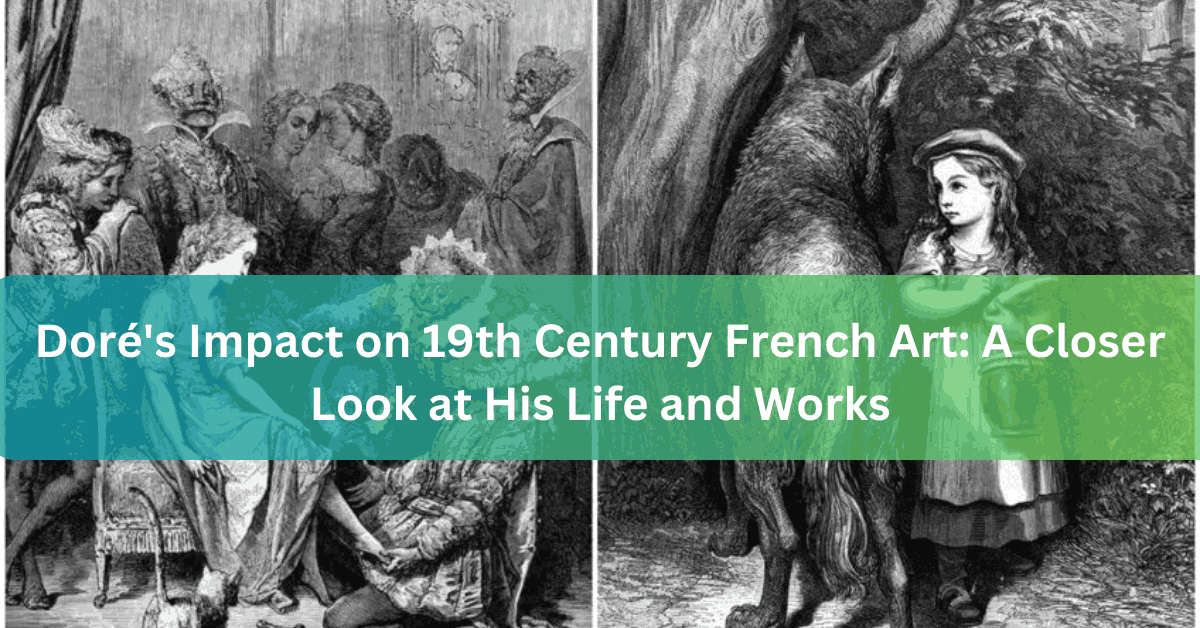Doré’s Impact on 19th Century French Art: A Closer Look at His Life and Works
In the vibrant tapestry of 19th-century French art, one name stands out with undeniable prominence – Gustave Doré. His impact on the artistic landscape of the time was nothing short of revolutionary. Let’s delve into the life and works of this influential artist in this closer examination of his legacy.
1. Early Life and Influences
Gustave Doré was born on January 6, 1832, in Strasbourg, France. His artistic inclination manifested at an early age, and by the time he was a teenager, he was already making a name for himself as a prolific illustrator.
Doré’s work was heavily influenced by the Romantic movement, which was sweeping through Europe during the 19th century. Romanticism, characterized by its emphasis on emotion, nature, and individualism, left an indelible mark on Doré’s artistic style.
Doré’s childhood was marked by an insatiable curiosity and an innate talent for drawing. His family recognized his artistic abilities early on, encouraging his pursuit of the craft. The city of Strasbourg, with its rich cultural tapestry, provided a fertile ground for the budding artist to draw inspiration from various influences, including the German Romantic tradition.
2. The Rise of a Prodigy
Doré’s talent quickly gained recognition, and by the age of 15, he was already making a name for himself as a prolific French illustrator.
His illustrations for works like “The Raven” by Edgar Allan Poe garnered widespread acclaim, showcasing his ability to capture the essence of the written word with visual flair. This early success laid the foundation for Doré’s future as a trailblazer in the art world.
The young artist’s rise to prominence was meteoric, and his reputation extended beyond France’s borders.
His illustrations became sought after not only for their technical brilliance but also for the unique way in which they breathed life into literature. Doré’s work was instrumental in popularizing illustrated books, setting the stage for a new era in publishing.
3. Mastering the Art of Engraving
One of Doré’s significant contributions to 19th-century art was his mastery of the art of engraving. His detailed and intricate engravings brought literature to life, making him a sought-after illustrator for notable works such as Dante Alighieri’s “Divine Comedy” and Miguel de Cervantes’ “Don Quixote.”
Doré’s skill in engraving was a testament to his technical prowess and his ability to elevate storytelling through visual representation.
His engravings not only complemented the narrative but also became an integral part of the storytelling process. The nuanced expressions of characters, the play of light and shadow, and the meticulous attention to detail distinguished Doré’s engravings from his contemporaries. These illustrations not only enhanced the text but often became inseparable from the stories they accompanied.
4. Doré’s Impact on Book Illustration
The 19th century witnessed a surge in the popularity of illustrated books, and Gustave Doré was at the forefront of this movement. His illustrations not only complemented the narratives but also enhanced the overall reading experience.
Doré’s work became synonymous with classic literature, and his collaborations with renowned authors solidified his position as a visionary in the realm of book illustration.
Authors sought Doré not only for his artistic prowess but also for his ability to encapsulate the essence of their narratives in visual form. His illustrations transcended mere accompaniments to the text; they became an integral part of the storytelling process, adding layers of meaning and emotion to the written word.
5. Exploring Doré’s Vision of the Fantastic
Doré’s artistic vision often leaned towards the fantastical and the otherworldly. His illustrations of fantastical landscapes and creatures in works like “The Adventures of Baron Munchausen” showcased his ability to transport viewers into realms beyond the ordinary.
The detailed intricacies of his fantastical depictions added a layer of enchantment to the narratives, captivating audiences and inspiring a new wave of artistic expression.
In his exploration of the fantastic, Doré demonstrated not only his technical skill but also his imaginative prowess. His ability to envision and render worlds that existed beyond the constraints of reality set him apart as a visionary artist.
The fantastical became a playground for Doré, where he could push the boundaries of conventional representation and immerse viewers in the extraordinary.
6. Doré’s Journey into the Dark and Macabre
While Doré was celebrated for his ability to bring fantasy to life, he also delved into darker realms with a series of illustrations depicting scenes from Dante’s “Inferno.”
His hauntingly beautiful renderings of hellish landscapes and tormented souls added a macabre dimension to his body of work. Doré’s exploration of the dark side showcased his versatility as an artist and his willingness to confront the complexities of the human experience.
The illustrations for “Inferno” were a departure from the whimsical and fantastical, delving into the depths of human suffering and sin.
Doré’s portrayal of the infernal landscapes was not merely a visual representation but a visceral exploration of the darker aspects of human nature. His ability to evoke both awe and terror through his art demonstrated the breadth of his emotional range as an artist.
7. Beyond Illustration: Doré’s Paintings and Sculptures
Although Doré gained widespread recognition for his illustrations, he was not limited to the world of pen and ink. As he matured as an artist, he ventured into painting and sculpture, showcasing a broader range of artistic skills. His paintings often carried the same dramatic flair as his illustrations, and his sculptures demonstrated a keen understanding of form and emotion.
Doré’s foray into painting allowed him to explore the interplay of color and light in a way that his monochromatic illustrations did not. His paintings, much like his engravings, often depicted scenes of grandiosity and drama, capturing the monumental moments of history and mythology. In his sculptures, Doré demonstrated a mastery of form, bringing his artistic vision into the tactile realm.
8. Doré’s Impact on Popular Culture
The influence of Gustave Doré extends far beyond the 19th century, permeating popular culture in unexpected ways.
His iconic illustrations have been adapted and reimagined in various forms, from album covers to cinematic productions. Doré’s imprint on popular culture serves as a testament to the timelessness of his work and its enduring impact on artistic expression.
Countless artists, musicians, and filmmakers have drawn inspiration from Doré’s visual language, incorporating elements of his style into their own creations.
The iconic images of Doré have become a part of the collective visual consciousness, resonating with audiences across different mediums. His impact on popular culture is a testament to the universality and adaptability of his artistic language.
9. Legacy and Recognition
Gustave Doré’s profound impact on 19th-century French art is indisputable, marked by his innovative approach to illustration, mastery of engraving, and exploration of diverse themes.
While facing contemporaneous criticism for commercialism, Doré’s contributions have undergone a reevaluation, cementing his position among artistic greats.
Beyond his individual works, Doré’s legacy transformed the perception of illustration, positioning him as a pioneering French illustrator whose technical prowess and imaginative vision elevated the craft.
Posthumously, his influence persisted and expanded, inspiring subsequent generations, prompting scholarly examinations, and sparking a renewed appreciation for the socio-cultural nuances within his art.
Doré’s legacy, preserved in museums and digitized for wider access, transcends traditional boundaries, resonating in popular culture and enriching our understanding of the intricate interplay between literature and visual art.
In conclusion, Gustave Doré’s impact on 19th-century French art goes beyond the confines of traditional artistic categorizations. As a French illustrator, he not only elevated the craft of illustration but also left an enduring legacy that transcends time and medium.
Doré’s ability to infuse storytelling with visual splendor, his mastery of diverse artistic forms, and his fearless exploration of both the fantastical and the macabre mark him as a true visionary. His legacy continues to evolve, inspiring contemporary artists and enriching our understanding of the dynamic interplay between literature and visual art.



